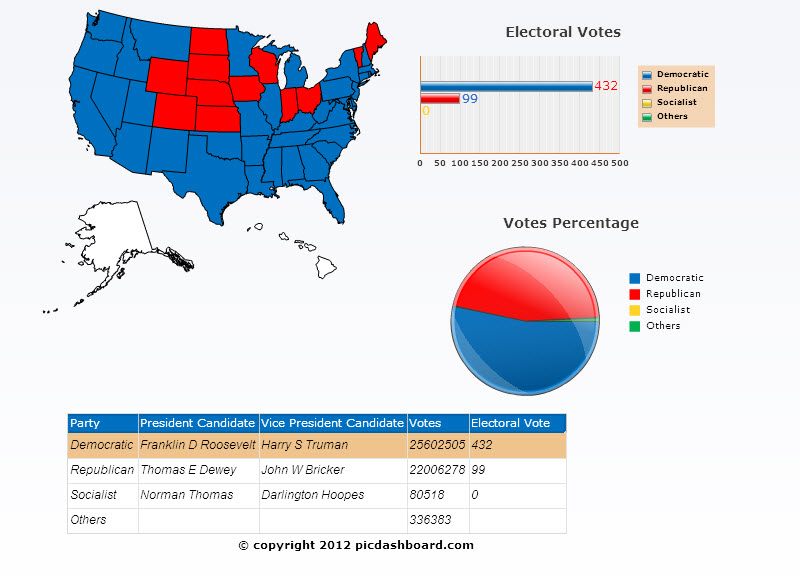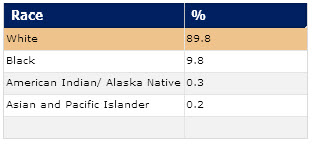Presidential Election of 1944
In the Presidential election of 1944, Democratic presidential candidate Franklin D Roosevelt defeated Republican presidential candidate Thomas E. Dewey with a margin of more than 7%.
FDR capitalizes on the success of US and the Allied forces in the World War II to win a comfortable victory over his Republican rival.
1944 Presidential Election Results
| Thomas E. Dewey | Republican Party |
| Democratic Party |

|
Political Situation:
1. Second Election after the start of the disastrous World War II.
2. First Election after the US entry into the World War II.
3. Russian and US forces sweeping across Europe, crushing Hitler's forces resistance.
4. Rumor's afloat regarding FDR's ill health.
5. FDR presses for another term, continues to cling to president seat sighting the fog of World War II.
Close States (margin<6%):
Connecticut, Idaho, Illinois, Indiana, Iowa, Maine, Maryland, Massachusetts, Michigan, Minnesota, Missouri, New Hampshire, New Jersey, New York, Ohio, Oregon, Pennsylvania, Wisconsin, Wyoming
Population by Race for the United States : Year 1940

|
|
Republican Party Agenda:
1. Execute the World War II till the end of all axis powers.
2. Shift US work force from war to peace time industries.
3. Equal pay rate for Women.
Biography of Franklin D. Roosevelt (Democratic party presidential candidate)
Franklin D Roosevelt was born January 30, 1882, in a fine old home overlooking the Hudson river, surrounded by trees and looking across a field where they had been cut for over a hundred years. His
godfather was Elliott Roosevelt, only brother of Theodore, who at that time
was beginning his political career.In 1900 he entered Harvard, to study law. Soon
after his graduation he married his distant cousin, Miss Anna Eleanor Roosevelt.
President Theodore Roosevelt considered her his favorite niece and,indeed, gave the bride away.
Franklin D. Roosevelt broke traditions even in his first campaign.
He talked to the voters from an automobile-then a detested "contraption" hated
by the farmers-and yet he was elected over his complacent opponent by a
strong rural vote. When Woodrow Wilson was elected President he offered the assistant
secretaryship of the navy to young Roosevelt. Six weeks after his 31st
birthday he took the oath of office, and from 1913 on he had under his immediate
direction the civilian personnel, the navy yards and docks, and the
purchasing of supplies.
In 1920 Roosevelt was nominated as the running mate with James M Cox. Public attention was soon after this to be focused sharply upon him. During a brief holiday he was stricken with infantile paralysis. Specialists
were hastily summoned in August, 1921, to a little island off the Maine coast.
It was generally believed that Roosevelt was apparently removed while still
a young man from the field of public endeavor.And yet we find him a year later back in his office, apparently "as
good as new.
As Governor OF New York
The first election was in itself a triumph. He was the first Democrat to carry upstate rural counties, being elected by a 25,000 majority in a year when the Republican party swept the country. The re-election of Roosevelt in 1930 was most dramatic. He took the campaign straight to the people and into the Republican strongholds. The result was the now-famous "landslide" victory
As President of USA 1932-1940
During his presidency between 1932 to 1944 Franklin D Roosevelt (FDR) repealed prohibition, introduced social security and unemployment benefits. USA economy continued to reel in great depression, but his policies as president eased suffering for a large number of Americans.His presidency between 1936-1940 Franklin D Roosevelt, saw the victory march of Hitler's forces across most of Europe. FDR resists calls of direct US involvement in Europe most notably from Great Britain. Rumors afloat about FDR's eagerness to enter World War II.
His presidency between 1940-1944 oversaw the rout of Hitler's forces across Europe and the Japanese forces where pushed back from various places in Asia.
